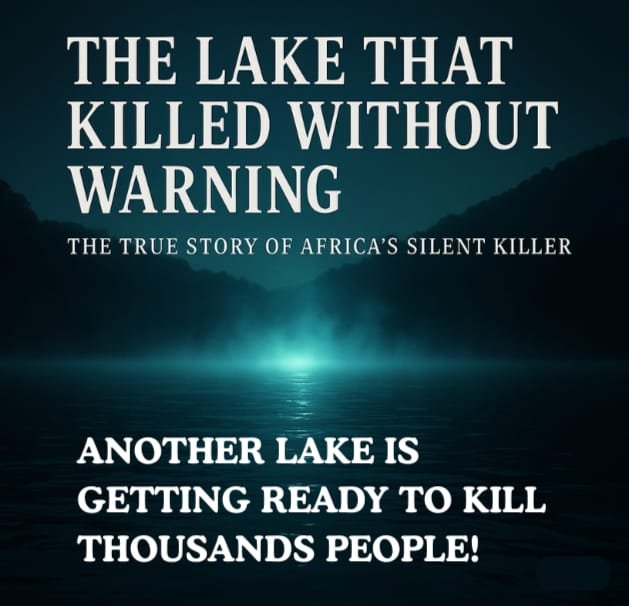The Lake That Killed Without Warning: The True Story of Africa’s Silent Killer And Another Lake Is Ready

In 1984, the scientific community encountered one of nature’s most terrifying faces. It was a phenomenon so strange and deadly that it silently claimed 37 lives without ever showing itself. In a remote part of Africa, people traveling along a road suddenly collapsed and died within a single minute.
The most shocking part was that every person died from the same cause: suffocation.
At first, locals believed it was an attack by evil spirits. Officials, on the other hand, called it a chemical attack. But when the real cause was discovered, it was almost impossible to believe.
The Night It Began
In August 1984, a terrifying event unfolded in the remote highlands of Cameroon, Africa. Near a peaceful body of water known as Lake Monoun, a deadly mystery was brewing.
The lake, surrounded by small villages and a nearby road, was known for its calm beauty until that night. On August 1, 1984, at around 11:30 p.m., locals heard a thunderous roar near the lake. At first, they assumed it was just a storm. But the sky was clear and stars glittered brightly above.
Those who were still outside noticed a strange fog hovering close to the ground near the lake. Thinking it harmless, everyone went home to sleep. But that fog was lethal.
The Morning of Death
By 10:30 a.m. the next morning, a breeze carried the fog toward the nearby road. Travelers assumed it was morning mist. But as soon as they entered it, they began choking and collapsing. Within minutes, dozens were dead on the road, in cars, and on motorbikes.
When the fog cleared, 37 bodies lay scattered across the area.
Police and doctors arrived quickly, but found no visible signs of violence or toxins. Initial investigations concluded that every death was due to asphyxiation. The mystery spread panic as people wondered how so many could die at once from suffocation.
Searching for Answers
Some villagers believed in supernatural forces. The government suspected a terrorist chemical attack. But scientists found both explanations baseless.
Why would terrorists target a small, remote African village?
Soon, attention turned to nature itself and specifically to the Cameroon Volcanic Line, a 1,600-kilometer underground chain of volcanoes stretching from the Gulf of Guinea deep beneath the African mainland right under Lake Monoun.
With help from the U.S. Embassy, a scientist named Harold Sigurdsson was called in to investigate. He found no signs of volcanic eruption, no sulfur particles, and no movement in the lakebed. But when he collected a bottle of water from the bottom of the lake, gas and bubbles erupted from it just like when you open a soda bottle.
That was the clue he needed.
The lake’s bottom water was saturated with carbon dioxide (CO₂).
Autopsies confirmed that the victims had died from carbon dioxide poisoning.
How a Lake Turned Deadly
Carbon dioxide is heavier than air, so when it escapes, it stays close to the ground just as the “fog” had done that night.
But why did the gas suddenly escape?
Sigurdsson’s research revealed that volcanic gases deep underground were slowly seeping into the lake bottom, dissolving into the water over many years. Because Lake Monoun lies near the equator, its surface water remained hot, while the bottom stayed cold.
Cold water is heavier, so it never mixed with the upper layers. Over centuries, carbon dioxide kept building up in the lower depths, forming a ticking time bomb.
All it needed was a small disturbance, perhaps a shift, a bubble, or internal pressure, and the gas would violently erupt.
That is exactly what happened that night. The roar people heard was likely the beginning of the eruption. This type of event later became known as a limnic eruption.
Sigurdsson published his theory after two years of study, but many scientists dismissed it as impossible.
Two Years Later: Lake Nyos Proves the Theory True
In 1986, just 100 kilometers north of Lake Monoun, another disaster struck, this time at Lake Nyos.
At around 9 p.m., villagers again heard a thunderous boom. Moments later, an enormous cloud of carbon dioxide, nearly one cubic kilometer in size, burst out of the lake containing more than 300,000 tons of gas.
Because CO₂ is heavier than air, the cloud rolled down into nearby valleys, suffocating 1,746 people and 3,500 animals within minutes.
Even insects and flies died, their absence making the silence more chilling. Only four people survived, all of whom were on higher ground. Some survivors were unconscious for 36 hours and woke to find their families dead.
Sigurdsson’s once-rejected theory was now proven true. The world finally understood the horrifying power of a limnic eruption.
What Triggered the Disaster
Experts found that a landslide had disturbed the lower layers of Lake Nyos, forcing the carbon dioxide to escape in one massive burst. The eruption was so violent that it even triggered a 25-meter-high tsunami inside the lake.
Afterward, scientists from around the world rushed to study both lakes and find ways to prevent future tragedies.
Preventing Another Disaster
Investigators found that both lakes were still building up dangerous amounts of gas. To reduce the risk, scientists proposed installing pipes to vent the gas safely from the depths.
This process, known as degassing, was carried out successfully:
- Lake Monoun was degassed by 2009
- Lake Nyos by 2019
The danger from these two lakes has now been largely eliminated.

But One Lake Still Poses a Global Threat: Lake Kivu
There is one more lake that could be far more catastrophic: Lake Kivu, located between the Democratic Republic of Congo and Rwanda.
Lake Kivu is so vast it could hold 50 Lake Nyos-sized lakes inside it, and it is twice as deep. It sits in a geologically active area and has the same conditions: stagnant layers and gas accumulation.
But there is a bigger danger, methane gas.
Unlike CO₂, methane dissolves less easily in water, meaning it can reach its saturation point faster, and it is flammable. If Lake Kivu erupts, the resulting cloud could ignite, turning a natural disaster into a fiery inferno.
Adding to the threat, two million people live around Lake Kivu. A major eruption there could become the deadliest natural disaster in human history.
Can It Be Stopped?
Scientists are monitoring Lake Kivu closely. A company called KivuWatt has begun extracting methane to generate electricity, but experts warn that the process is too slow and may even risk triggering an eruption if not handled properly.
The wars and instability in the region make large-scale safety operations nearly impossible.
The Deadly Legacy of the Lakes
Lake Monoun showed the world what a limnic eruption is.
Lake Nyos revealed its devastating power.
Lake Kivu now holds the potential for something even worse.
Given the ongoing conflicts and dense population around it, scientists warn that Lake Kivu may be the most dangerous lake in the world, a silent giant with the power to kill millions
Sources –
Lake Monoun – https://en.wikipedia.org/wiki/Limnic_eruption
Lake Monoun – https://pubs.usgs.gov/publication/70032981
Lake Nyos – https://en.wikipedia.org/wiki/Lake_Nyos_disaster
Lake Nyos – https://pmc.ncbi.nlm.nih.gov/articles/PMC1836556/
Lake Kivu – https://www.nature.com/immersive/d41586-021-02523-5/index.html







